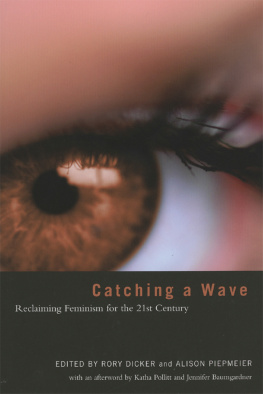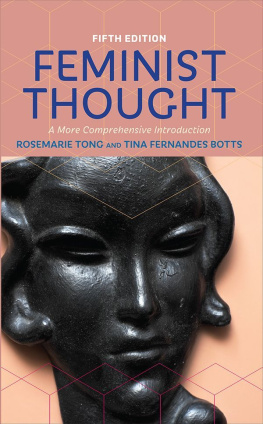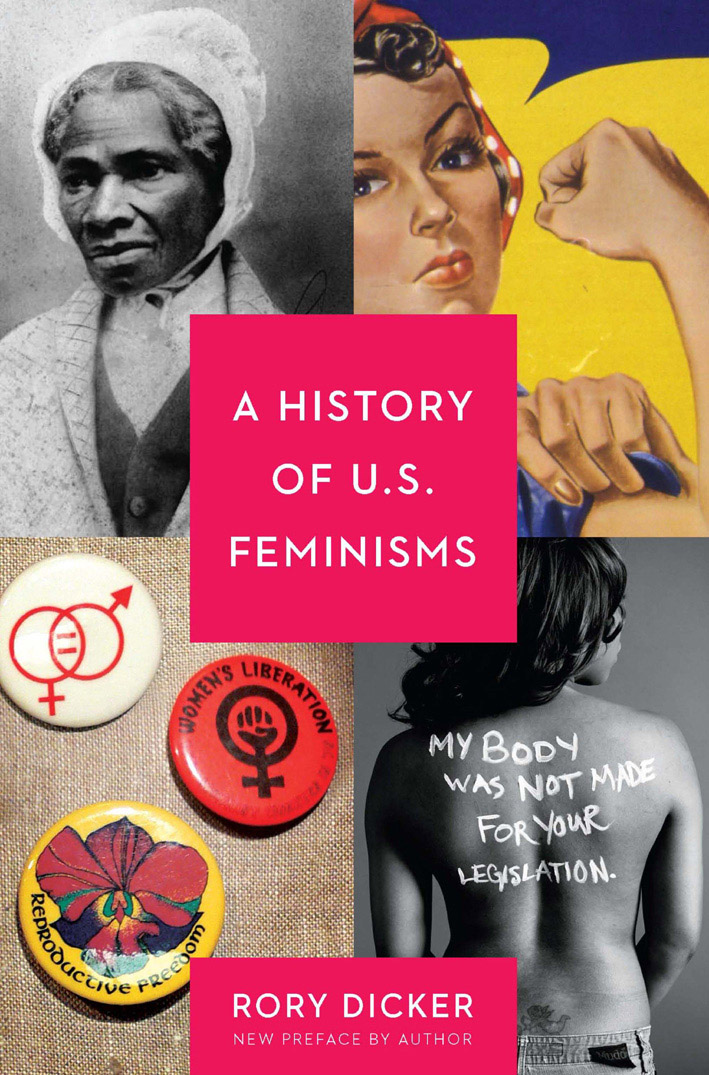

A History of U.S. Feminisms
2016, 2008 Rory Dicker
Published by Seal Press
a member of the Perseus Books Group
1700 Fourth Street
Berkeley, CA 94710
All rights reserved. No part of this book may be reproduced or transmitted in any form without written permission from the publisher, except by reviewers who may quote brief excerpts in connection with a review.
Library of Congress Cataloging-in-Publication Data
Dicker, Rory Cooke, 1969
A history of U.S. feminisms / by Rory Dicker.
p. cm.
ISBN-13: 978-1-58005-614-4
1. FeminismUnited StatesHistory. 2. Womens rightsUnited StatesHistory. 3. WomenUnited StatesHistory. I. Title.
HQ1420.D55 2008
305.420973dc22
2008005241
Cover design by Tim Green, Faceout Studio
Cover photos (top left) Hulton Archive / Staff/Getty Images; (top right and lower left) Wikimedia Commons; (bottom right) Liora K Photography, http://www.liorakphotography.com/
Book design by Mike Walters
Printed in the United States of America
Distributed by Publishers Group West
10 9 8 7 6 5 4 3 2 1
For Saul Dicker
(19402007)
Table Of Contents
Guide
CONTENTS
A LOT HAS CHANGED IN THE FEMINIST LANDSCAPE since the first edition of A History of U.S. Feminisms appeared in 2008. To state the most obvious, Hillary Clinton campaigned for the Democratic nomination for president in 2008; she is seeking the nomination in the 2016 election as I write this. Barack Obama, the man who received the Democratic nomination and became president for two terms, has shown his support of feminism in various ways. The Lilly Ledbetter Fair Pay Act of 2009, the first significant legislation signed by President Obama, helps protect individuals against pay discrimination; in addition, the president has made policies such as affordable childcare and mandatory paid family leave a part of his State of the Union addresses. President Obamas commitment to ending sexual assault on college campuses has led to a stricter enforcement of Title IX, the law that protects people from sex discrimination at educational institutions receiving federal funding. The Obama administration created the White House Task Force to Protect Students from Sexual Assault and launched the Its On Us public awareness and education campaign, which asks people to prevent sexual assault by developing new social norms about masculinity and bystander intervention.
Perhaps because I have two young daughters, I notice the ways society has started to show more concern about the experience of girls, not just in terms of sexual assault, but in terms of girls intellectual development and their growth in confidence. Although this may be a trivial example, the popularity of the Disney film Frozen indicates that young girls, tweens, and their parents crave movies that feature relationships between female characters. Even though it is marketed as just another Disney princess movie, the film is different: in this movie, Prince Charming turns out to be a schemer, romantic love is not the focus, and sisterhood is powerful. Indeed, the love story of the two sisters is what is most central to the narrative. Like Frozen, other recent cultural creations show a desire to take girlsboth young and adolescentseriously. Not long before I saw Frozen in early 2014, I heard about GoldieBlox, a toy company that, by encouraging girls interest in building and designing structures, hopes to address the underrepresentation of females in STEM (science, technology, engineering, and mathematics) fields. An ad for GoldieBlox and the Spinning Machine depicts three girls delighting in the construction of a Rube Goldberg machine in their house, garage, driveway, and yard. The ads soundtrack, an unauthorized remake of the Beastie Boys Girls, asserts that girls are tired of pink and pretty playthings and instead deserve to see a range of toys, particularly those that allow them to use [their] brains. Although GoldieBlox is packaged in pink, its goal is to value girls for their intellect and their potential as problem-solvers. Another product for girls, this one aimed at teenagers, is Rookie, an online magazine launched in September 2011; through its features that focus on everything from astronomy and camping to manicures and flower arranging, the magazine illustrates that it is okay for girls to be interested in both femininity and feminism. Rookie affirms girls wide-ranging interests as part of a process of self-discovery.
Just as some parts of the culture are focusing on girls, commitments to difference and equality feel more central to daily life than ever before. For instance, public opinion of same-sex marriage has shifted in the last ten years, from 36 percent in favor in 2005 to around 60 percent in favor in 2015. President Obamas endorsement of marriage equality in 2012 may have helped change some peoples perceptions on the issue, but the Supreme Courts ruling in 2013 against a key part of the Defense of Marriage Act has led to real changes for gay couples, who are now able to access the same federal benefits received by straight couples. Furthermore, the Supreme Courts ruling in Obergefell v. Hodges in 2015 legalized same-sex marriages in all fifty states. Gay and lesbian members of the armed services felt real effects, too, when the Dont Ask, Dont Tell policy mandating the hiding of sexual orientation at the risk of being discharged was repealed in 2010. The presence of transgendered individuals in the news media and popular cultureLaverne Cox, Janet Mock, Chelsea Manning, and, most recently, Caitlyn Jennerhas led to a greater awareness among the general public of the inequality experienced by people whose bodies do not match their internal sense of their gender. The term cisgender, which refers to a person whose understanding of their gender aligns with the sex they were assigned at birth, is used with more frequency now than it was in 2008, when this book was first published.
Although there has seemed to be a groundswell of support for trans and gay rights, in other ways, American society seems to be moving backward. The repeated killings of unarmed black menTrayvon Martin, Eric Garner, Michael Brown, Freddie Gray, to name only the most prominent onesby neighborhood vigilantes or police officers smacks of Jim Crow-era injustice at a time when the United States has its first black president. Even though he was not shot or killed by the authorities, the case of Kalief Browder, a black teenager arrested for stealing a backpack and held at Rikers Island jail without trial for three years, almost two of which were spent in solitary confinement, received attention when it was the subject of a profile in The New Yorker. Although Browder was released in 2013, despair from his treatment and all he had lost during his three years of captivity led him to take his own life in 2015. In response to the way mainstream society seems to consider black people unimportant and meaningless, the #BlackLivesMatter movement, begun in 2013, protests the structural racism that leads to police brutality, the mass incarceration of black men, and the belief that black people are disposable.
A different example of society seeming to regress has to do with reproductive rights. When Sandra Fluke, then a student at Georgetown Law School, testified in 2012 before the House Democratic Steering and Policy Committee about why Georgetowna Catholic institutionshould provide health care coverage for contraceptive drugs, the conservative radio host Rush Limbaugh called her a slut and a prostitute. Limbaughs comment was hardly an isolated one; a couple of months earlier, Foster Friess, a donor supporting Rick Santorums bid for the presidency, stated that, when he was young, women used Bayer aspirin for contraception. The gals put it between their knees, and it wasnt that costly. Because of remarks such as these, some referred to a Republican War on Women in 2012, a war that moved beyond vitriol and included the discussion or passage in state legislatures of bills that would restrict access to abortion, including those that would force women to undergo an invasive transvaginal ultrasound before they could have an abortion. Another state legislator, Joe Walsh, a Republican congressman from Illinois, added to this war by declaring that abortions are absolutely never medically necessary to save the life of a woman: With modern technology and science, he averred, you cant find one instance. There is no such exception as life of the mother, and as far as health of the mother, same thing. Although comments such as these were criticized immediately and even had political repercussions for those who made them, the clear antifeminist subtext of these statements was hard to miss. For example, when Todd Akin, a Republican candidate for the U.S. Senate from Missouri, shared his views on abortion and stated that legitimate rape rarely leads to pregnancy, he quickly lost support for his Senate campaign; his statement revealed a kind of ranking of sexual assault which did not sit well with victims, advocates, or feminists.











